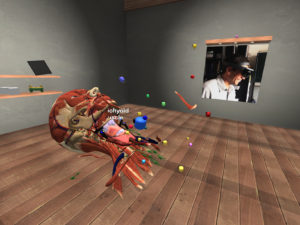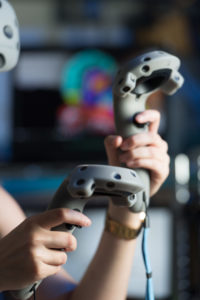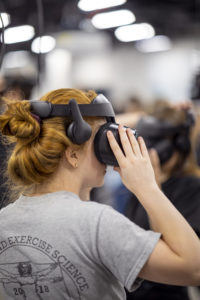When COVID-19 reared its ugly head, wreaking havoc on education for students all over the world, CSU’s human virtual reality program stepped up to meet the moment.

“We knew that teaching an entire human gross anatomy class remotely with only pictures would not be ideal for students,” said Tod Clapp, an associate professor in the Department of Biomedical Sciences and head of its human anatomy program.
Moving BMS 301, Human Gross Anatomy, to online-only instruction this summer meant that students would not only miss out on the chance to work with and learn from real human cadavers, they would also miss getting to experience the new 100-person virtual reality lab Clapp’s team built last fall.
“So we decided to try and take what we had already been doing in virtual reality and completely refactor it so that we could do it remotely,” Clapp said.
Clapp and his team of developers moved quickly to innovate a unique software solution for conducting remote virtual reality and acquired the resources necessary to ship computers and headsets to all enrolled students before the eight-week summer session began on June 15.
The result was a promising pilot program that wrapped up with the last day of classes today and exceeded everyone’s expectations.
Practically in-person
Each morning of class students launched into a common virtual classroom, appearing as customized avatars, for discussions, case studies, and demos before breaking into lab groups. With the click of a button they could “raise their hand” and ask questions through their headsets, engaging with the instructors, TA’s and with one another in real time as they dissected 3-D cadaver models and interacted with real clinical data such as MRI’s and CT scans.

“It’s been amazing to jump into a ‘classroom’ from home and join students as they dissect a virtual cadaver,” said Carolyn Meyer, an assistant professor in the Department of Biomedical Sciences and instructor in the course. “We can talk about the structures and integrate information from the lectures just like we do in our in-person lab.”
When Clapp saw groups of students studying in their virtual lab groups outside of class he popped in to check on them, just as he always did in person when walking the halls.
“When I talk to a student, my avatar turns toward them and theirs turns toward me,” Clapp said. “We can have a conversation while facing each other and then turn back toward the data. It’s tough to describe the level of engagement, but it’s darn close to when you’re in a real space together.”
Helping students thrive in a changing world
Tori Hoelscher, a biomedical sciences master’s student who hopes to attend medical school and work in pediatrics someday, had never experienced virtual reality and didn’t know what to expect. Due to the hands-on nature of the class, she worried about being able to get the same education remotely.

“But it really mimicked what it would have been like in person,” Hoelscher said. “And there are things you can do with a 3-D cadaver in virtual reality that you couldn’t dream of doing with a human cadaver, like expand the heart big enough to fit yourself inside of a ventricle—on a real person you would never be able to see things from that perspective. Plus, it was cool to still be able to see and communicate with classmates and study with a core lab group. It was very rewarding to be part of such a neat pilot project.”
Initially, when lead developer Chad Eitel and research associate Jordan Nelson found out in April that they needed to help Clapp pull off putting 100 students in virtual reality remotely by June, they thought he was crazy. “But the class operated better than we could have imagined,” Nelson said. “It has been incredible to see how quickly students have been able to pick up the technology and take control of their education. We’ve all had to face the changing reality of education during this pandemic and providing students with an experience that is as similar to the cadaver lab as possible has been our highest priority.”
“We took a chance and developed everything in-house, and we’re three years down the road now,” Clapp said. “It’s been a lot of fun to develop this together as a team.”
With the course now built and tested Clapp would love to run it again, even with the return to in-person cadaver dissections. “It can expand our teaching capacity and allow at-risk students to stay home and distance students to stay where they are,” Clapp said. “It’s not geographically limited and we hope to see it continue.”